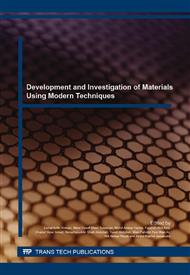[1]
W.E. Lee, Y. Iqbal, Influence of mixing on mullite formation in porcelain, J. Eur. Ceram. Soc. 21 (2001) 2583–2586.
Google Scholar
[2]
M.K. Haldar, S.K. Das, Effect of substitution of sand stone dust for quartz and clay in triaxial, Bull. Mater. Sci. 35 (2012) 897–904.
DOI: 10.1007/s12034-012-0377-4
Google Scholar
[3]
A.R. Jamaludin, S.R. Kasim, M.Z. Abdullah, Z.A. Ahmad, Sago starch as binder and pore-forming agent for the fabrication of porcelain foam, Ceram. Int. 40 (2014) 4777–4784.
DOI: 10.1016/j.ceramint.2013.09.023
Google Scholar
[4]
T. Ohji, Chapter 11. 2. 2 - Porous Ceramic Materials, Second Ed. Elsevier Inc., (2013).
Google Scholar
[5]
N.M. Bobkova, N.I. Zayats, T.V. Kolontaeva, G.B. Zakharevich, Porous Glass Ceramic Bioimplants, Glas. Ceram. 57 (2001) 412–414.
DOI: 10.1023/a:1010977625309
Google Scholar
[6]
J.P. Wu, A.R. Boccaccini, P.D. Lee, M.J. Kershaw, R.D. Rawlings, Glass ceramic foams from coal ash and waste glass: production and characterisation, Adv. Appl. Ceram. 105 (2006) 32–39.
DOI: 10.1179/174367606x81632
Google Scholar
[7]
A.A. Ketov, Peculiar Chemical and Technological Properties of Glass Cullet as a Raw for Foamed Insulation Material, in: Int. Symp. Recycl. Reuse Glas. Cullet, (2003).
Google Scholar
[8]
H.R. Fernandes, D.U. Tulyaganov, J.M.F. Ferreira, Production and characterisation of glass ceramic foams from recycled raw materials, Adv. Appl. Ceram. 108 (2009) 9–13.
DOI: 10.1179/174367509x344971
Google Scholar
[9]
E. Bernardo, Micro- and macro-cellular sintered glass-ceramics from wastes, J. Eur. Ceram. Soc. 27 (2007) 2415–2422.
DOI: 10.1016/j.jeurceramsoc.2006.10.003
Google Scholar
[10]
D.U. Tulyaganov, H.R. Fernandes, S. Agathopoulos, J.M.F. Ferreira, Preparation and characterization of high compressive strength foams from sheet glass, J. Porous Mater. 13 (2006) 133–139.
DOI: 10.1007/s10934-006-7014-9
Google Scholar
[11]
B.E. Yekta, P. Alizadeh, L. Rezazadeh, Floor tile glass-ceramic glaze for improvement of glaze surface properties, J. Eur. Ceram. Soc. 26 (2006) 3809–3812.
DOI: 10.1016/j.jeurceramsoc.2005.12.016
Google Scholar
[12]
C. Voigt, E. Jäckel, C.G. Aneziris, J. Hubálková, Investigations of reticulated porous alumina foam ceramics based on different coating techniques with the aid of μCT and statistical characteristics, Ceram. Int. 39 (2013) 2415–2422.
DOI: 10.1016/j.ceramint.2012.09.001
Google Scholar
[13]
D.D. Brown, D.J. Green, Investigation of strut crack formation in open cell alumina ceramics, J. Am. Ceram. Soc. 77 (1994) 1467–1472.
DOI: 10.1111/j.1151-2916.1994.tb09744.x
Google Scholar
[14]
B.A. Movchan, F.D. Lemkey, Some approaches to producing microporous materials and coatings by EB, Surf. Coatings Technol. 165 (2003) 90–100.
DOI: 10.1016/s0257-8972(02)00723-5
Google Scholar
[15]
H. Zhang, W.J. Suszynski, K.V. Agrawal, M. Tsapatsis, S. Al Hashimi, L.F. Francis, Coating of Open Cell Foams, Ind. Eng. Chem. Res. 51 (2012) 9250−9259.
DOI: 10.1021/ie300266p
Google Scholar
[16]
A.R. Jamaludin, S.R. Kasim, A.K. Ismail, M.Z. Abdullah, Z.A. Ahmad, Fabrication of porcelain foam substrates coated with SiC, Ni, and Cr using the dip-coating technique, Ceram. Int. 41 (2015) 2940–2947.
DOI: 10.1016/j.ceramint.2014.10.123
Google Scholar


